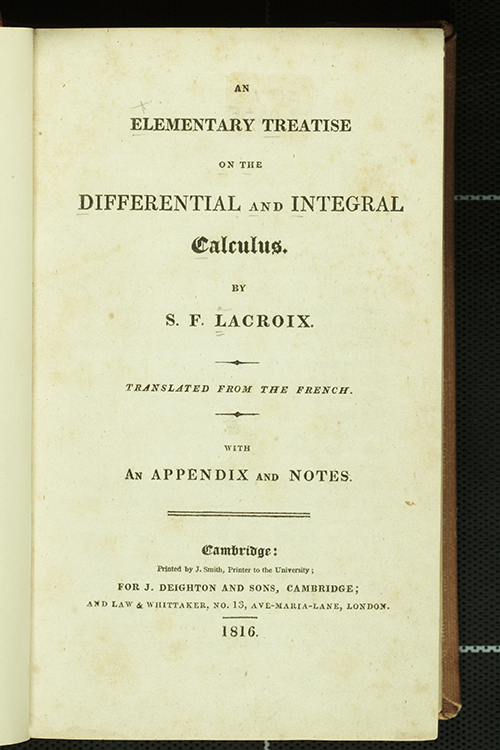- About MAA
- Membership
- MAA Publications
- Periodicals
- Blogs
- MAA Book Series
- MAA Press (an imprint of the AMS)
- MAA Notes
- MAA Reviews
- Mathematical Communication
- Information for Libraries
- Author Resources
- Advertise with MAA
- Meetings
- Competitions
- Programs
- Communities
- MAA Sections
- SIGMAA
- MAA Connect
- Students
- MAA Awards
- Awards Booklets
- Writing Awards
- Teaching Awards
- Service Awards
- Research Awards
- Lecture Awards
- Putnam Competition Individual and Team Winners
- D. E. Shaw Group AMC 8 Awards & Certificates
- Maryam Mirzakhani AMC 10 A Awards & Certificates
- Two Sigma AMC 10 B Awards & Certificates
- Jane Street AMC 12 A Awards & Certificates
- Akamai AMC 12 B Awards & Certificates
- High School Teachers
- News
You are here
Textbooks of Lacroix: Differential and Integral Calculus
Sylvestre Lacroix (1765-1843) was a French mathematician and Professor of Mathematics in several post-revolutionary French institutions of higher education. He spent much of his career teaching at the École Polytechnique in Paris. Lacroix was a textbook writer of wide scope who incorporated into his works the revolutionary concept that knowledge should be for public consumption. As a result of this innovation, his textbooks were adopted and adapted throughout Europe and the early United States of America.

Perhaps Lacroix’s most influential books were the comprehensive calculus text, Traité de calcul differéntial et du calcul intégral (1797-1798), and the calculus text he himself used for teaching, Traité élémentaire de calcul differéntial et du calcul intégral (1802). In 1816, the latter book was translated from French to English by Charles Babbage, George Peacock, and John Herschel at Cambridge University, and adopted for the teaching of calculus there. This action exposed English students of mathematics to the “continental mathematics.” The title page of the English translation of this revolutionary book is shown above.

The “Advertisement” on page iii, above, explains the undertaking of the translation.

The “Advertisement” continues on page iv and the “Table of Contents” begins on page v.

The remainder of the “Table of Contents,” above, reveals the topics of study. Lacroix’s calculus texts were the first mathematics books to introduce the term “analytic geometry.”

Pages 4 and 5, above, contain an explanation of the differentiation process. The differential of an expression is defined using the example \(f(x)=ax^3\) and \(f^{\prime}(x) =3ax^2.\)
The images above are supplied through the courtesy of the Rare Books and Manuscript Collection of the Pennsylvania State University Library and the assistance of Dr. Sandra Stelts, Curator of the Collection.
Reference
J. J. O’Connor and E. F. Robertson, “Sylvestre François Lacroix (1765-1843),” MacTutor History of Mathematics Archive.
Frank J. Swetz (The Pennsylvania State University), "Textbooks of Lacroix: Differential and Integral Calculus," Convergence (June 2015)




